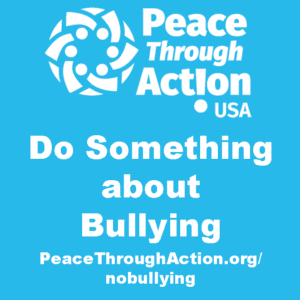What is bullying?
Bullying is unwanted, aggressive behavior that involves a real or perceived power imbalance between victim and perpetrator.[1] The behavior can include threats, rumors, verbal and/or physical attacks, and group exclusion.[2] When the behavior occurs electronically, using phones, computers, or tablets, it is called cyberbullying.[3] Adults can experience bullying, although the issue is more commonly considered and addressed as a violence of concern for children and youth.
[1] Stopbullying.gov. Bullying Definition. Retrieved from https://www.stopbullying.gov/what-is-bullying/index.html
[2] Ibid.
[3] Stopbullying.gov. What is Cyberbullying. Retrieved from https://www.stopbullying.gov/cyberbullying/what-is-it/index.html
How widespread is bullying in the United States?
- 21 percent of students ages 12-18 experience bullying at school.[1]
- 19 percent of males and 23 percent of females ages 12-18 report bullying at school.[2]
- 22 percent of Whites, 25 percent of Blacks, 17 percent of Hispanics, and 16 percent of Asians ages 12-18 experience bullying at school.[3]
- 19 percent of adults experience workplace bullying.[4]
[1] U.S. Department of Education. (December 2016). Student Reports of Bullying: Results From the 2015 School Crime Supplement to the National Crime Victimization Survey. Retrieved from https://nces.ed.gov/pubs2017/2017015.pdf
[2] Ibid.
[3] Ibid.
[4] Workplace Bullying Institute. (June 23, 2017.) 2017 WBI U.S. Workplace Bullying Survey. Retrieved from http://www.workplacebullying.org/2017-prevalence/
What culture changes and public policies are necessary for preventing bullying?
Raising awareness about bullying through print materials and public service announcements on radio, TV, and social media can be helpful.[1] Engaging parents and youth through awareness campaigns, committees, and task forces can also help in sending a clear message about the unacceptability of bullying.[2] Assessing the problem of bullying in a community through research and surveillance is important to addressing the problem.[3] Studying community strengths and challenges can be helpful in determining who is impacted by bullying and how to respond to the issue within a community’s schools, businesses, and churches.[4]
[1] Ibid.
[2] Ibid.
[3] Stopbullying.gov. Prevention at School.
[4] Stopbullying.gov. Working in the Community. Retrieved from https://www.stopbullying.gov/prevention/in-the-community/index.html
What practical solutions are effective for preventing bullying?
Implementing social and emotional learning cultures and practices in schools and bullying prevention and response training in schools and workplaces can help to stop bullying.[1] And, bystander intervention is a technique that equips people with awareness, skills, and courage to intervene in situations, including bullying, when another individual needs help. Learn more about these practical peaceful solutions in our Choose Peaceful Practices series of information pages.
[1] Ibid.
What can I do to prevent or stop bullying?
- Intervene immediately. If you spot bullying happening, “nip it in the bud.” Don’t let the problem flourish. Getting another adult involved with you if that would allow you to feel more comfortable.[1]
- Separate the people involved.[2]
- Make sure everyone involved is safe.[3]
- Youth themselves, please be kind to the person being bullied. Show them that you care by including them. Sit with them at lunch or on the bus. Invite them to do something with you. Just hanging out with them will help them know they aren’t alone.[4]
- Get help from a school official, healthcare provider, or even the police if necessary if there is threat of or actual physical harm, sexual abuse, or hate-motivated violence.[5]
- In case of emergency—If you are experiencing or witnessing an emergency resulting from bullying, call 911 or try to get to a location where others can observe your distress and intervene.
[1] Stopbullying.gov. Stop Bullying on the Spot. Retrieved from https://www.stopbullying.gov/respond/on-the-spot/index.html
[2] Ibid.
[3] Ibid.
[4] Stopbullying.gov. What Kids Can Do. Retrieved from https://www.stopbullying.gov/kids/what-you-can-do/index.html
[5] Ibid.
Where can I find statistics about bullying?
- School Crime Supplement to the National Crime Victimization Survey—https://nces.ed.gov/pubs2017/2017015.pdf
- Centers for Disease Control and Prevention (CDC) Youth Risk Behavior Surveillance System—https://www.cdc.gov/healthyyouth/data/yrbs/index.htm
- Workplace Bullying Institute U.S Workplace Bullying Survey— http://www.workplacebullying.org/wbiresearch/wbi-2017-survey/
- Centers for Disease Control and Prevention (CDC) Fast Facts on Preventing Bullying— https://www.cdc.gov/violenceprevention/youthviolence/bullyingresearch/fastfact.html
Where else might I go to learn more about bullying?
Government agencies, nonprofit organizations, research centers, and/or think tank organizations with expertise in bullying include:
- stopbullying.gov—a federal government website
- American Psychological Association—leading organization representing psychology in the United States
- National Crime Prevention Council—leader in crime prevention
- PACER National Center for Bullying Prevention—social change initiative to prevent childhood bullying
Do Something about Bullying (PDF)
Page Author: Safiya Mojerie (volunteer)
Have a suggested improvement to this information sheet? Send it to inbox@peacethroughaction.org
Do Something Right Away to Increase Peace
Subscribe to our YouTube channel
Give a gift of money to support our mission delivery activities
Choose opportunities to take part in our #PeaceBeginsWithWe campaign

